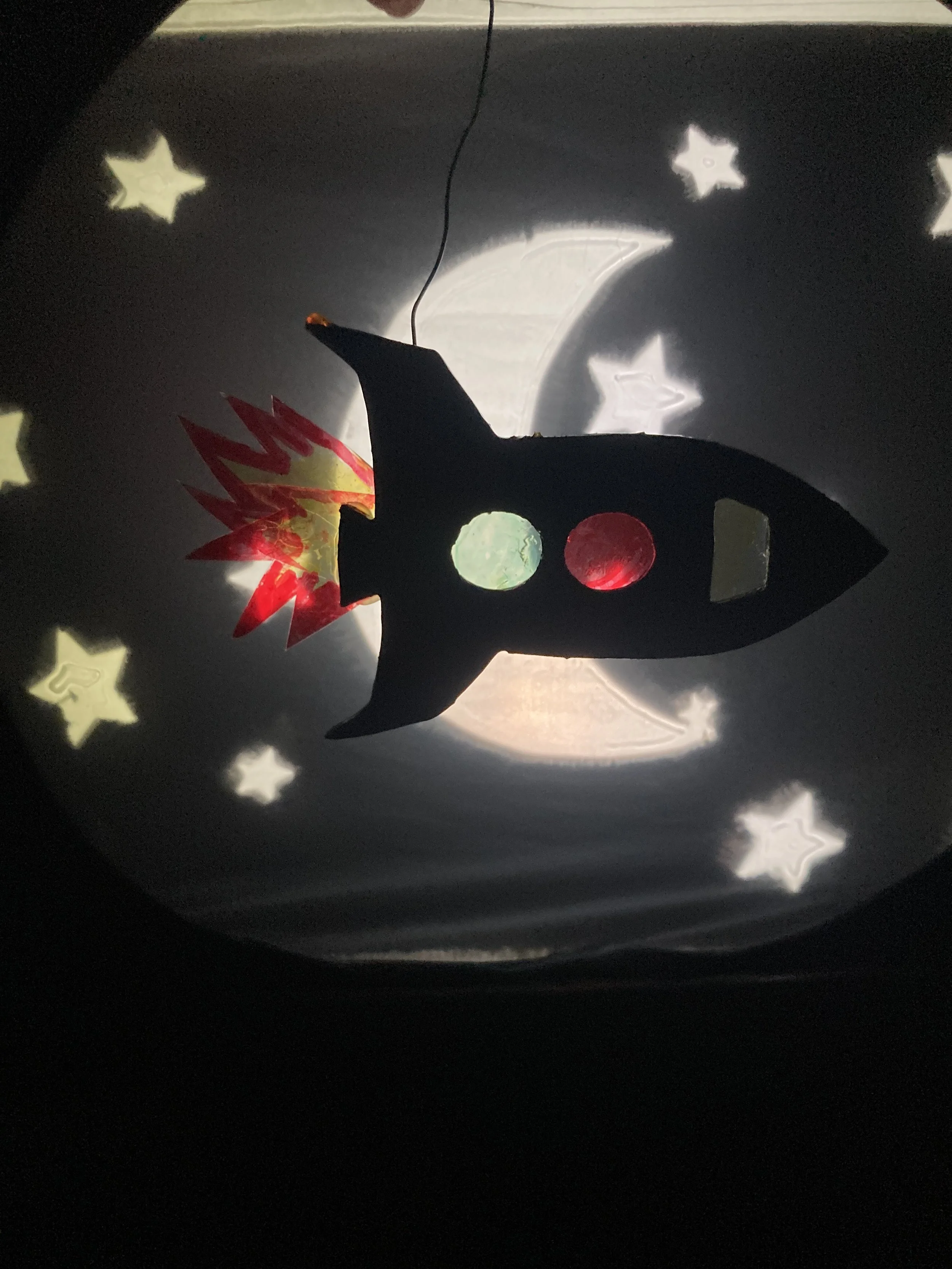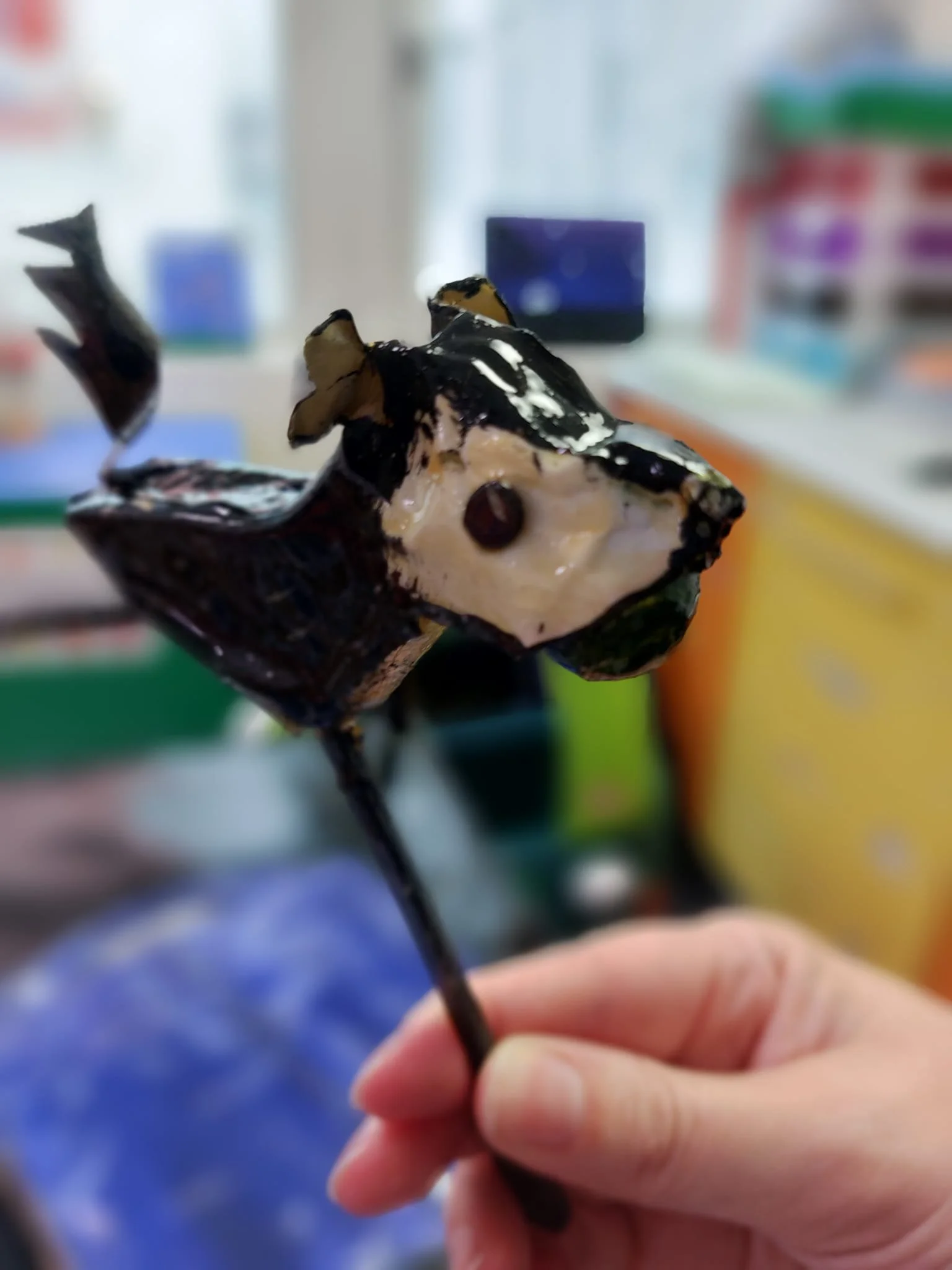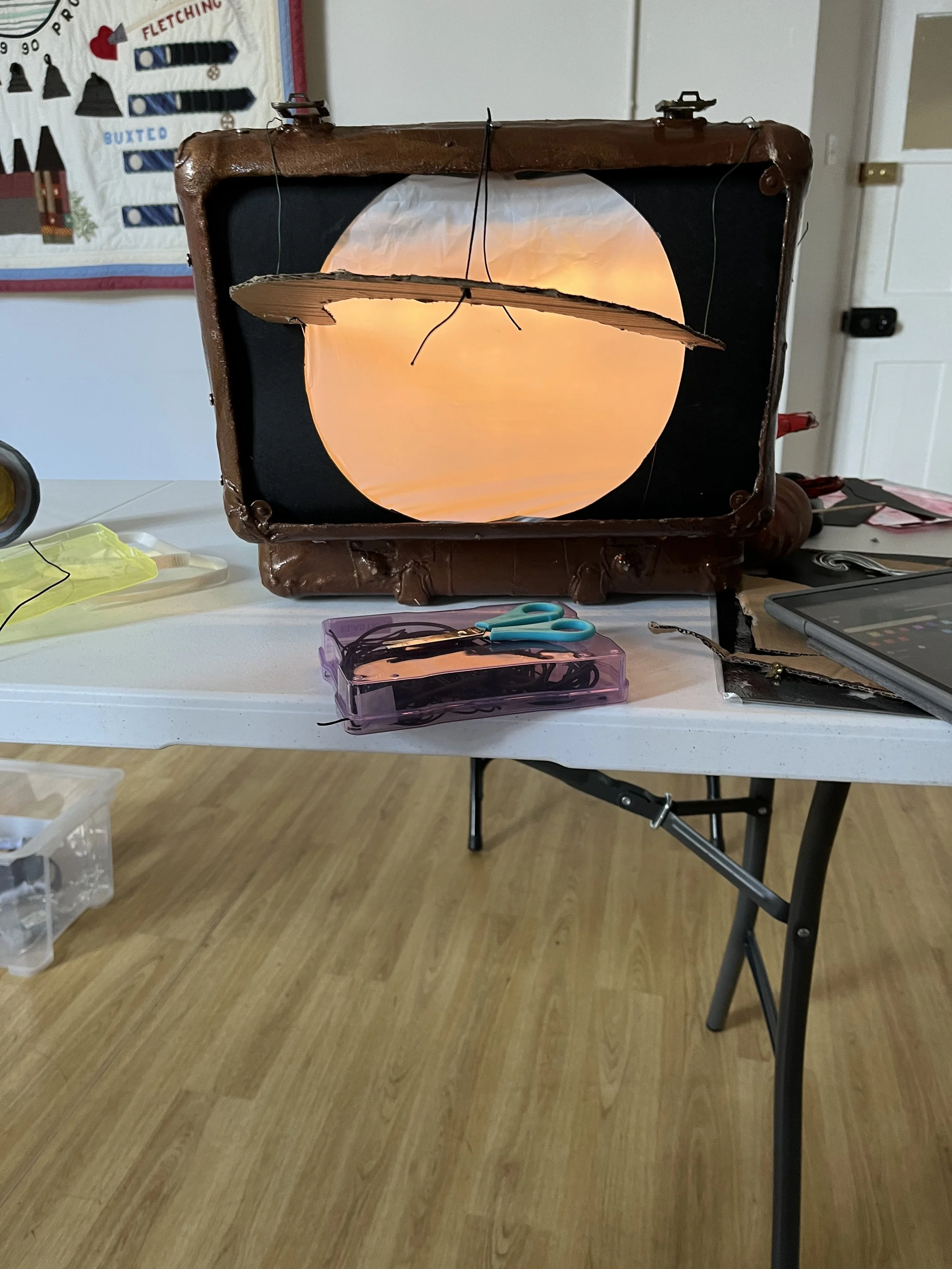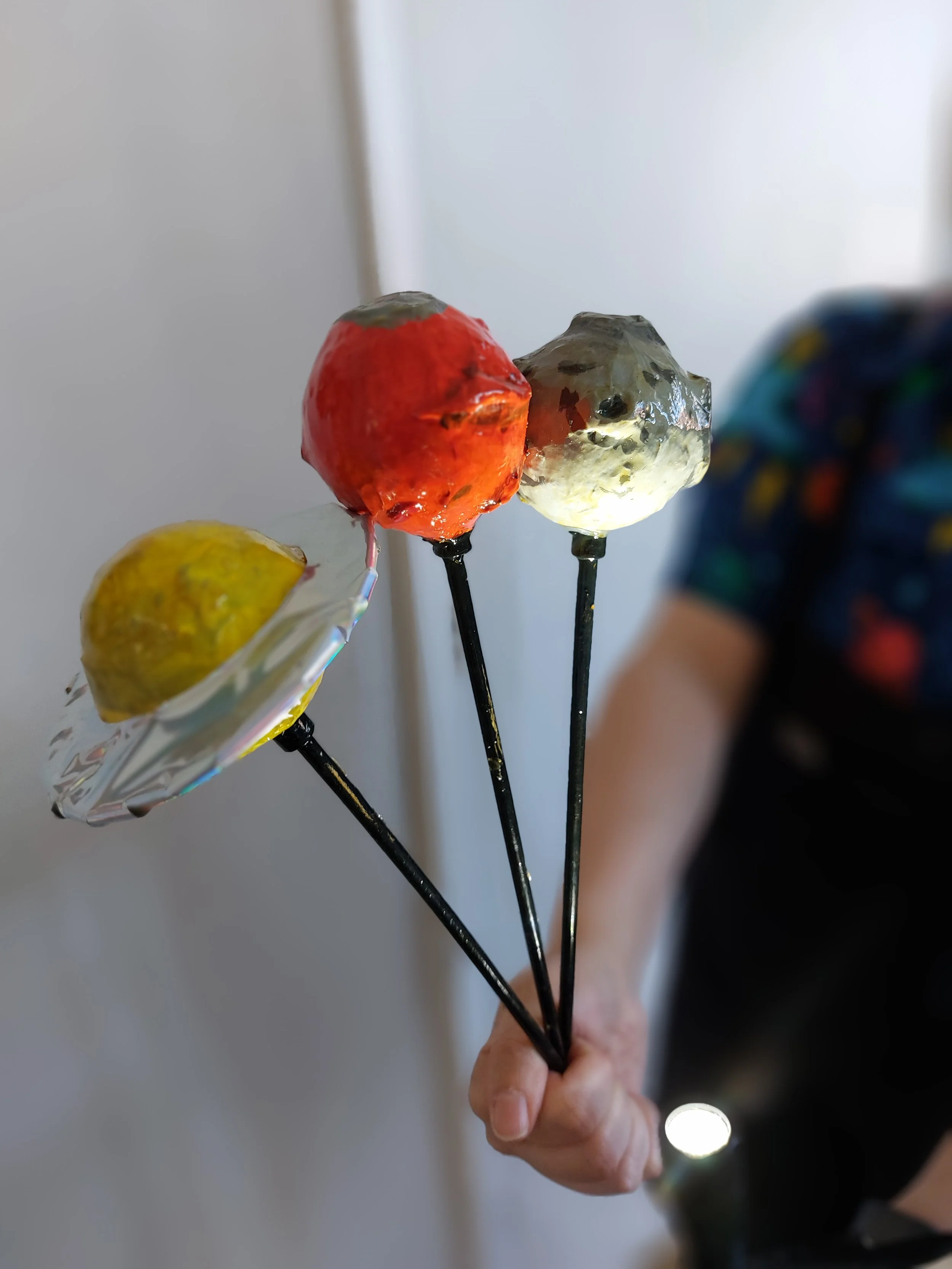sPACE dOG
Mark and Joni discuss the development and refinement of Space Dog
Listen to the audio with the button above and you can read the transcript!
TRANSCRIPT
Mark
I think the second piece that we sort of worked on was because we knew how well space went in the first iteration, yes, where we had that was the closest we came to this actually, because it began as just Twinkle, twinkle, little star, yes, with stars, which then when a rocket went into space, and then we had, we had our own little routine. I went into Sigur Rós, for a while, a you took off into space, and we went around a few planets. So we always knew it was going to be… that space just works.
Joni
And that was, like, my favorite one to do, if we could just, sort of… it's funny, because we kind of used to decide what what the patients were going to see. We sort of would make a decision between ourselves, which is quite different to how we do things now, where we've got more of a menu. Although sometimes we still… space dog is definitely for the younger children. So there's sometimes we're like, “I think this is probably going to be most enjoyable for you, rather than something that's so narrative, like the penguin and stuff like that,” sort of keeps the attention a little bit more.
Mark
We kept Space Dog as a very sensory… it's about the lights, it's about the planets. It's about, yeah…
Joni
But yeah, we knew space worked. I think, I think we went with a Space Dog because it was we had, we had a conversation about what would sort of…. would patients most likely gravitate towards, like a human puppet or an animal puppet? We spoke to someone, and she was like “animals, almost sort of guaranteed they love animals,”
Mark
Because I think we are… We thought about that you can humanize an animal, you can project yourself into an animal, but when there's a human there, you don’t… you might empathize with the character, but the human… you know, it's not the same process. They are a person, but the space dog can be anyone.
Joni
Yeah, I think it's sometimes, it's harder to for the for the patient, to see themselves in a human character because, you know, unless, unless it's sort of more plain, so that they can project onto, onto The puppet. It is… It's actually really hard to sort of, yeah, make a puppet that any, any, like any… I think any child would sort of enjoy watching, but actually sort of seeing themselves in is really tricky.
Mark
It’s also, I think animals are quite cute. It's easy to empathize, sort of like with an cute animal, but a person is heavier, isn't it? It's a human And they may be good, maybe bad, there may be anything, maybe funny, but they're not just, you don’t have that initial “Oh!” you're not instantly as grabbed as with an animal. And you can take the animal anywhere. The animal can be anything.
Joni
But I feel like we had quite big ideas for for Space Dog, and a big one of those, because we're thinking about when we visited the planets in the sort of the Twinkle, Twinkle Little Star Medley that we did. (They were all medleys) that was the visiting the planets. So we wanted this dog to go visit, go visit planets. And we kind of, again, wanted to lean into that, children having having a choice in what they see. So we kind of wanted it to be a sort of, kind of choose your own adventure. You choose the planet or one of them was the moon…
Mark
We set it up that the dog goes into space, and then you could choose which… either it was Mars moon and Saturn, wasn't it? And each one was a completely different story, completely different music. You had to design three separate shows, essentially for each planet. And it was good, but I think we found Saturn had a… uses a 3D ring around the shadow.
Joni
That was your idea.
Mark
It looks really cool
Joni
Because the screen is round, so you've got that planet shape. And we had the lighting grid thing from the penguin, so that we could make different sort of planets, basically. And it fits so well, like that idea was so good. So there was such a charm to Saturn,
Mark
I'm quite good at coming up with ideas about any real basis of how much work is into making them. “Oh, that would be cool” That could be five minutes or five days. I don't know how long it is to realize, but…
Joni
Our process sometimes boils down to you going, “Oh, could we do this?” And then my brain goes, “Yes, oh, dear, right. How do we make that happen? Because it's a nice idea,” and then magically it happens. But, yeah, that's a that was a very simple, very simple, to just put a ring on the screen.
Mark
Yeah. I mean, I think that we kind of favored that one, didn't we? And I think that people tended to be, I'd say that was chosen more, but I was the most that we got…
Joni
Yes, I think mostly because we had these little planets so that children could point or touch or indicate which one that they were interested in, and if they sort of couldn't communicate verbally, sometimes it was easier for Play team or nurses or family members to, you know, sort of touch, touch the planets and sort of get an indication of which ones the patient wanted. But Saturn had a shiny ring on it, holographic shiny paper on it!
Mark
It did draw people to it! But it was the most sensory, satisfying one, I think because it had that extra 3D element, the lights and the music was very… all the music for them all is very gentle. That one, it was very rhythmic, and just worked really well. And then, sometimes we’d do the moon and we’d do Mars, but it didn't, I felt like we're always trying to bring those two up to Saturn.
Joni
There was a time where you wanted to cut Mars because,
Mark
I did
Joni
Because it just, it wasn't, it wasn't Saturn standard. And I was desperate. I was just like, “No, I what I want there to be three choices, and I know Mars can be good,” because the… Mars was probably the most sort of story, one like Saturn was so it was just pure, beautiful sensory-ness. And in fact, was one if, if we thought the patient was maybe too young to choose one of the other ones, where it's a little bit more story…
Mark
Because the choice isn't always appropriate, depending on the situation, you know, sometimes it's really nice, but other times it's just, is to be just, you know, if it's a very young baby, isn't there? Yeah, you know,
Joni
And we think they're just enjoy, enjoy the colors, and enjoy the dog and all of that. But yes, Mars was definitely, you had more of a story about the Space Dog, meeting the
Mark
Mars Rover dog, which was another robot dog
Joni
And going, and we just couldn't quite get it right. And I was getting really like, “No, I can make it look beautiful.” And then there was one point where I sort of had this cut out of like a galaxy, and with the sort of the moving lights that we had, it looked animated. It looked really lovely. There was because it's several LEDs, it can make, sort of like cut out shadow puppets look like they're moving. Which, which, when we discovered that in rehearsal, that was such a game changer. I loved that. I spent far too long just just looking through it. “This looks cool. It's not for this project, but this is really cool," Yes and then Mars, Mars didn't get chosen until they got chosen once. And I think we were both so surprised
Mark
We were like “what?!”
Joni
That it then began to feel like, “Oh, this feels a little clunky, actually.” And the moon was quite the moon went through a couple of stages, because -
Mark
A couple of cycles
Joni
A couple of cycles at the moon, just sort of trying to find, like, what a dog would do on the moon. And we introduced this constellation dog, and all of this.
Mark
It was mainly playing with a ball, wasn't it? Obviously the ball was floating up, but the dog was floating up. Yes, like together. It was very nice.
Joni
I did really enjoy
Mark
It also, I guess because you had to set up three shows, you had to have all three of them ready to go. And it was a lot in the background, because,
Joni
Because I set up as each child sort of chooses from a menu. Basically, we've just got, you know, the images of the puppets, not the puppets or sort of what they are the puppets. They're the shadow puppets that I've just sort of put into and just to sort of show like little glimpse of what, of what the show might look like. So they choose, and then I set up, and you usually plays music, and I hastily try and set it up, and you're right with the Space Dog. It was so much stuff, and there was puppets layering on top of puppets
Mark
Because each planet used completely different puppets, completely different light settings, they were three really distinct things.
Joni
I colour coded the ends of the shadow puppets like they've got their little rods to help me. So it was that much of just like, “oh my goodness, what’s needed?” And I guess…
Mark
We just cut it down, didn’t we?
Joni
Yeah, we just cut it down…
Mark
What we've got, we've kind of taken the best bits of all of them into this really nice and it’s… I've taken because… each planet had its own musical theme, original musical theme would not be the classical planet. And now the show has a bit of all of those, so the music changes a little bit. It's little moments. We have a big thing about the rocket taking off, and it just works so much nicer.
Joni
Yeah, it's a little bit less frantic on my part. And like you said, it's just taking little bits from each of the so we sort of stick with Saturn. We know Saturn's really beautiful and lovely, and we've expanded it. And I think it was also, you know, the time between setting up, between, you know, mid show, I think was just taking too long, and it was sort of losing the engagement of the of the patients. And we knew that they really liked Saturn and Saturn really, just really worked. That sort of, sort of the feedback that we were getting, wasn't it? So we sort of, yeah, just stuck everything together, and now it's so much better for me. There's bits I miss. I miss the choice of it, but, you know,
Mark
but I think it really works, and I think that we can take our time a lot more in the transitions. It's just a much more relaxed show, which I think makes it more relaxed for the patients, because it is. It's more sensory. It's more of a sleepy one. It'd be the bedtime one. We go off into… there's a nice bit now, like you have the effects of Mars. You have that now with the stars, and it’s just really nice.
Joni
Yeah, yeah. It's so much more peaceful. And, you know, we still keep, you know, the planet changing, so there's, it still has a lot of what really worked in when we did Twinkle Twinkle, our version of Twinkle, Twinkle, Little Star of that traveling to different planets.
Mark
I think looking back through Space Dog from where it was at the beginning as an idea to where it ended up, it feels like that was a sort of lesson to learn and that, because it was the choice, it was really nice and it was really good, but because the choice led to a completely different show. It was a bit too big, and actually honing it down and being simpler made it richer, made the whole thing better, I think so that's something we can take forward with Other things that the scale of idea can come down, but that might make the actual performance better. Sometimes it means it gives you more to play with in a funny way and less to fit in.
Joni
Yeah, and but I'm glad we went on that journey, sort of the literal space journey of trying these little different bits. And, you know, because we found lots of lovely music from that, I think, yeah, yeah. We sort of took bits from from all of those sort of separate teeny weeny shows, and it's come so, like you said, it's now richer because there's been these ideas that we've explored. So it's not a lesson of, never go to that scale.
It's a lesson of, it's all right to go to that scale, but simple, especially in this environment, especially with what we're trying to achieve, is always better, you know. and it sort of reflects some of our later developments, where we came up with a show, filmed it for, sort of For our documentation, then went “that was 17 minutes!” It was too long. But again, it was that sort of, let's push, let's like, see how far we could take this. But actually simple, especially, you know, if it was just, if we only did Space Dog, if that was the only show that we did, I can imagine that sort of branching off would be really lovely.
Mark
It would work really well.
Joni
It would work really well. But because we've got all of these, the choice comes in, the choosing of what show the patient sees. And we want to offer lots of different vibes and different, you know, different stories essentially, it just doesn't work. It's just one thing too many, you know, and I think the variety of choice that we have in what show a patient could choose is kind of more important than making the shows that we have sort of too big. I sort of think of like, because everything's on a trolley, and it's like, if things need start needing separate boxes for for one show, that's when we've gone too big,
Mark
Especially because there's room for room for improvisation as well. So with three choices, things about deviate even further, depending on what's happening, it just became, it became so big, but yeah, didn't lose sense of what it was, but compared to how it is now, we have a really nice, strong sensory exploration, and it can children can take it anywhere if I want.
Joni
And I think you're right in the way that actually looking back, splintering off those choices. I think we, we lost that sense of improvisation. There wasn't the space anymore. In the Space Dog, there wasn't the space to improvise. Because we went, right, we've got this, and then we need to make sure that we go to here.
Mark
It took the freedom out of. Whereas now we've got the freedom back.




